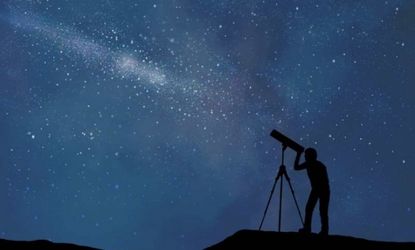Behold: The biggest object in the known universe
The Huge-LQG stretches 4 billion light-years across at its longest point

It's a great big universe, and we're all really puny. Yes, humankind is probably even more insignificant than we could have ever imagined, thanks to new findings from a team of astronomers in the U.K. For the odd-looking heptagon structure seen here represents the largest observable object in the known universe.
The Huge-LQG (Large Quasar Group), as it's been dubbed, is a grouping of 73 quasars, or galactic nuclei — which are all thought to have been at the heart of their own respective galaxies at one point — and stretches 4 billion light years across its longest axis. Our very own Milky Way galaxy, in comparison, is a microscopic 100,000 light-years across.
In fact, as Eric Mack at CNET points out, it would take "tens of thousands of our own Milky Ways" to equal the tremendous size of the Huge-LQG.
Subscribe to The Week
Escape your echo chamber. Get the facts behind the news, plus analysis from multiple perspectives.

Sign up for The Week's Free Newsletters
From our morning news briefing to a weekly Good News Newsletter, get the best of The Week delivered directly to your inbox.
From our morning news briefing to a weekly Good News Newsletter, get the best of The Week delivered directly to your inbox.
What does the Huge-LQG's discovery mean? Well, it casts into doubt a little something called the cosmological principle, which asserts that Earth's position in the universe isn't as special a vantage point as once believed. The principle suggests that if "viewed on a sufficiently large scale, the properties of the universe are the same for all observers." So, according to the principle, if you gaze out into the universe from any point (say, this potentially inhabitable exoplanet), then space should look consistent no matter the direction from which you're looking.
But the Huge-LQG throws a colossal monkey wrench into the theory: The object is simply too big, too unusual a shape to fit neatly into the homogenized lines of the cosmological principle. It could mean our little corner of the cosmos — or at least what we can see of it — is exceptional. Unusual, even. Speaking with The Atlantic, study lead Roger G. Clowes at the University of Central Lancashire explains that the cosmological principle "seemed plausible, but it's never been demonstrated beyond reasonable doubt."
In any case, all this means for you is that the big, beautiful blue marble we call Earth is, relatively speaking, a speck on a speck on a speck. On a speck. A little something for us wee Earthlings to keep in mind after the next time we miss an "important" work email.
Sign up for Today's Best Articles in your inbox
A free daily email with the biggest news stories of the day – and the best features from TheWeek.com
-
 How will Elon Musk's alliance with Donald Trump pan out?
How will Elon Musk's alliance with Donald Trump pan out?The Explainer The billionaire's alliance with Donald Trump is causing concern across liberal America
By The Week UK Published
-
 Netanyahu's gambit: axing his own defence minster
Netanyahu's gambit: axing his own defence minsterTalking Point Sacking of Yoav Gallant demonstrated 'utter contempt' for Israeli public
By The Week UK Published
-
 Crossword: November 16, 2024
Crossword: November 16, 2024The Week's daily crossword puzzle
By The Week Staff Published